You have surely heard about the Oktoberfest. There is no way around it because it is the world’s most visited folk festival.
Every year, this event attracts millions of visitors from all over the world. Definitely, you’ve been there yourself or at least know someone who has visited Oktoberfest. Even we, as Limak Hotels are enthusiastic fans of this big festival in Munich.
But what is behind the “Wiesn,” as Munich’s citizens call their city’s festival? Which traditions have been kept at our planet’s biggest beer festival since its beginnings, and what changed during the years?
This is what you are going to know after reading this blog post.

An extended Guide to Oktoberfest
When is Oktoberfest held?
The name Oktoberfest makes a bit of a misnomer, unfortunately. Despite its name, this famous festival primarily takes place in September. It opens in the middle of September and ends on the first Sunday in October.
So if you want to know when Munich opens the city’s biggest beer festival, just have a look at the calendar. Choose the first Sunday in October and then go back for two weeks. The corresponding Saturday is the day when Munich’s mayor officially opens this festival.
The Oktoberfest has been held every year since 1810. However, there have been years when the city must have canceled the festivities. The latest time this happened was in 2020 and 2021. It was the first time since 1945 that the city had to cancel the Oktoberfest.
The reason was the risk of spreading the new type of coronavirus, which caused a worldwide pandemic. However, even before that, there were years in which wartime or pandemics forced the cancellation of Germany’s famous festival.
Do you want to take part in Oktoberfest or just want to visit Munich? Then have a look at Skyscanner, there you will find dozens of cheap flights to Bavaria’s capital.
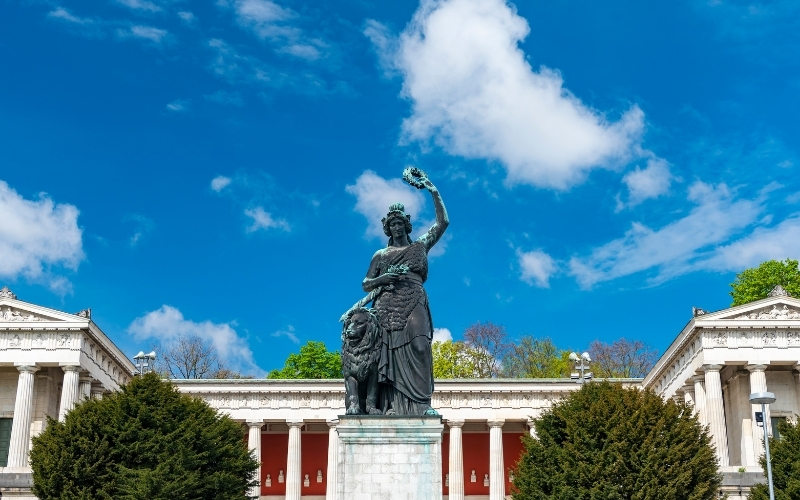
Theresienwiese — Where It Takes Place
By now, the Wiesn has more than 200 years of history. Over time, there have been numerous changes at Bavaria’s largest folk festival.
Only one constant exists; that is where the residents of Munich and guests from all over the world enjoy this event. This place is the Theresienwiese.
You find this square of about 42 hectares in the very center of Munich. Its location is in the neighborhood Ludwigsvorstadt-Isarvorstadt. Starting in the old town, you can easily walk to this square where this event takes place.
From Theresienwiese, you can also spot a few interesting sights. Particularly famous is the statue of Bavaria, which you can discover in the west of the Theresienwiese.
She is considered the patron saint of Bavaria and keeps a watchful eye over the Oktoberfest venue. You can even take a spiral staircase up to this 18-meter-high statue’s very top.
From there, you have an impressive view of the Theresienwiese and the hustle and bustle of the Oktoberfest.
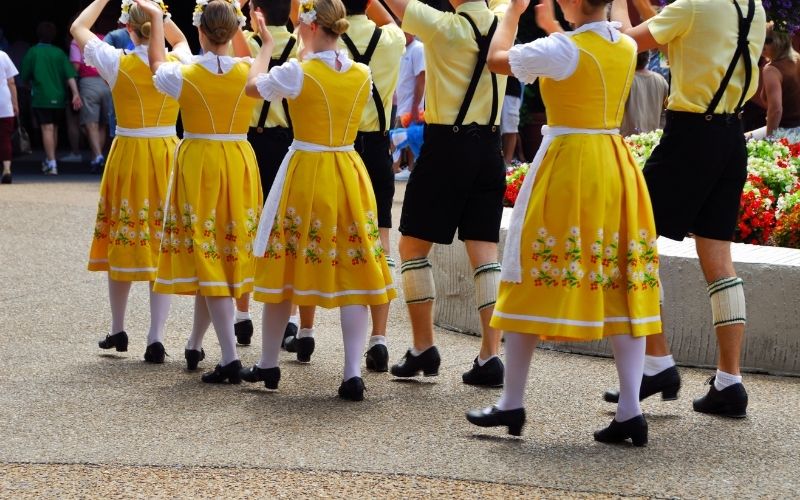
Oktoberfest Traditions
The Beginning
The opening of the Munich Oktoberfest occurs with a celebratory ceremony. Before that, the hosts of the breweries enter Theresienwiese with decorated horse-drawn carriages.
If you have the opportunity, you should definitely witness this spectacular event. The innkeepers travel all over the city, and the people of Munich are still passionate about this tradition until now.
A woman dressed in a yellow and black frock leads the procession. She represents the “Münchner Kindl,” the city symbol of Munich. It also decorates the coat of arms of the Bavarian capital.
Furthermore, the music bands of the individual festival tents accompany this festive event.
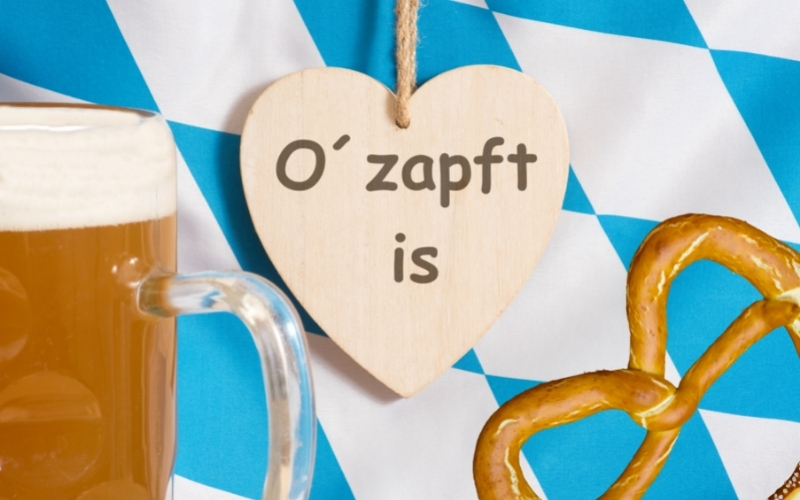
Tapping the First Beer
At around midday, the “Schottenhamel” tent serves the first beer. Munich’s mayor taps the first barrel of beer. Once he successfully attached the tap to the keg, he utters the magic words that every visitor to the opening ceremony is waiting for: “O’zapft is!”.
This officially marks the opening of the Oktoberfest. To make sure that even people who couldn’t get a seat in the Schottenhamel tent will know about it, they hear twelve gunshots from the steps of the Bavaria statue at this very moment.
By the way, there is even a small competition to see how many blasts the mayor of Munich needs. The current record is two blasts, established by the last two lord mayors. It took the longest in 1950; this year, the mayor needed 19 strokes.
By tradition, the first beer is given to the Bavarian prime minister. As soon as he has taken the first sip, the other festival tents get the signal to tap their first kegs.
From that point on, the festival innkeepers can offer their beer to everyone who visits the festival.
Costume Parade
On the first Sunday, there is also the traditional costume parade. This tradition was introduced in 1835 for the silver wedding anniversary of King Ludwig I.
As with the procession of the festival innkeepers, the “Münchner Kindl” leads the parade. Several thousand people dressed in traditional costumes start at the Maximilianeum and walk to the Theresienwiese.
In contrast to the procession of the festival innkeepers, associations that are not based in Munich are also allowed to take part.
There are also regular participants from Austria, Switzerland, the northern Italian region of South Tyrol, and several other countries.
Of course, it can be exhausting to walk around on your own around the festival square. For some help, there are some Oktoberfest tours available.
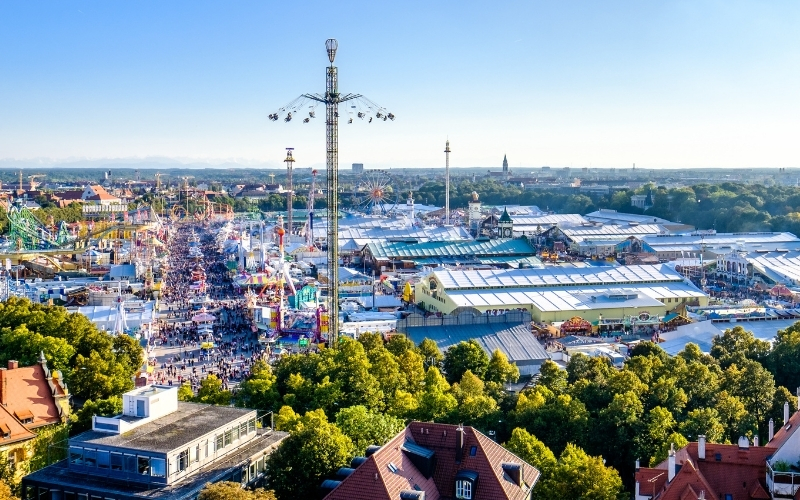
History and Its Origins
Today, the annual six million or so visitors are more interested in pouring liter after liter of beer into their bodies. But in the beginning, Oktoberfest was entirely different from that event you know today.
It all began in 1810 in the form of a huge horse race. Almost unbelievable that today it has developed into the largest folk festival in the world.
Andreas Michael Dall’Armi, a member of the Bavarian National Guard, came up with the idea for this event. The former Prince Ludwig, who later became King of Bavaria, married Princess Therese of Sachsen-Hildburghausen, and Michael Dall’Armi wished to organize a unique celebration of this event.
Incidentally, the bride’s name is also the reason the square where millions of people celebrate the Oktoberfest until now listens to the name Theresienwiese. At that time, however, you could not find any trace of today’s festival tents.
The festival, as you might have guessed, enjoyed great popularity. For this reason, all visitors wanted to experience such celebrations on a regular schedule. From the next year on, the “Agricultural Association in Bavaria” organized the at that time still manageable folk festival.
More and more, the event, which was initially planned as a wedding celebration, changed into an opportunity for farmers to spotlight their achievements.
In 1819, the city of Munich took over the organization of the festival. They knew that the Oktoberfest would attract significant visitors every year and bring plenty of money to the city. So, it was clear that the city authorities had a strong interest in holding this folk festival regularly.
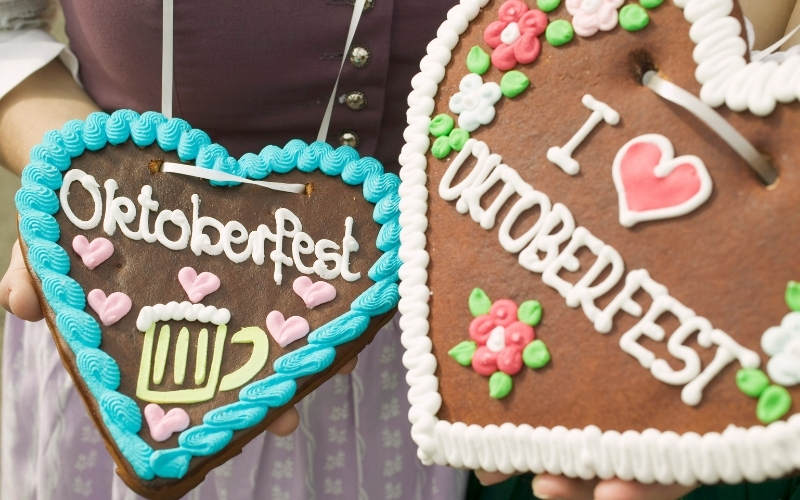
How It Changed During Ages
Obviously, a festival with such a long tradition has also experienced a lot in its history. In 1850, one of the most critical milestones in the history of the world’s largest folk festival was the unveiling of the statue of Bavaria, which you can still see today near the Theresienwiese. She is considered the patron saint of the Oktoberfest and also the personification of Bavaria.
Subsequently, though, there were some rather difficult years. Considering the numerous problems also felt in Munich, hardly anyone had any desire for the crazy celebrations in Bavaria’s capital. Mainly, wars and the cholera epidemic dampened the mood of the people of Munich to celebrate.
A few decades later, there was the next new development. In 1881, the first chicken roastery opened. Today, this spit-roasted chicken is one of the classical specialties you will find on Oktoberfest. You can name it in the same sentence with terms like pretzel or beer without being looked at askance by others.
By the end of the 19th century, electric lights continued to change the face of Munich’s folk festival. Gradually, the Oktoberfest developed into that event you already know today. More and more showmen constructed their rides. In addition, the request for beer rose so strongly that the Munich breweries now built up gigantic festival tents instead of small booths.
It still took some time for the city festival, which was visited by numerous people, to develop into what you know it as today. Another milestone in its history was the year 1910, which marked the 100th anniversary of the Oktoberfest.
Accordingly, the festival had the highest rush of guests up to that time. The Bräurosl, the marquee of the Munich brewery Hacker Pschorr, offered a total of 12,000 seats. In 1950, another tradition started, and visitors still celebrate it today.
Since then, the mayor of Munich taps the first beer keg at the Schottenhamel. With the words “O’zapft is,” he officially signals the start of the two-week event. A tragic event in the history of this event was the Oktoberfest bombing in 1980, which killed 13 people.
Munich’s Citizens Start To Criticize Oktoberfest
In the following years, criticism came more and more from many inhabitants of Munich. Although it was still considered a folk festival, more and more Munich residents thought their city festival to be an event that was gradually losing its charm. A record chased the next, may it be the number of visitors, the amount of beer drunk, or the city’s revenue.
The fact that the Oktoberfest was moving further away from its tradition did not go down well with all its visitors. Especially for families, it was a true imposition that it was no longer about Bavarian culture. Instead, the focus was increasingly on partying.
Of course, the city administration also understood that the “Wiesn” was supposed to be interesting mainly for the citizens of Munich. That’s why, since 2005, the rule has applied that the festival hosts should only play Bavarian brass band music until 6 pm. After that, the festival hosts have permission to play any kind of music in their tents again.
For enthusiasts of the origins of the Munich folk festival, there has been another interesting attraction since 2010. The so-called “Oide Wiesn” was originally intended to be held only on the 200th anniversary to commemorate the beginnings of the festival, which is now attended by millions of people from all over the world.
The program aims primarily at families with children. In addition, after a long time, the city held a horse race to remind the beginning of the Oktoberfest. Originally, the “Oide Wiesn” was to take place only this year. However, it became so popular that the organizers decided to hold it every year from then on.

Typical Oktoberfest Foods and Drinks
There is nothing more representative of Munich’s well-known festival than beer. The breweries attending the Oktoberfest even brew an exceptional beer for this event. It has a higher alcohol content and contains more wort than ordinary beer.
All breweries that sell their beer at the Oktoberfest have their headquarters in Munich. The major representatives of Munich’s brewers are Augustiner, Paulaner, Hacker-Pschorr, Löwenbräu, Spaten and Hofbräu. On Wikipedia, you get a complete overview of all the Oktoberfest tents.
By now, Munich’s second-largest private brewery, Giesinger Bräu, also plans to enter the Wiesn. Originally, this was to be in 2020, but this year and the following year, Munich has canceled the folk festival due to the corona pandemic.
By the way, beers are served in special beer glasses. These are the so-called Maß, a vessel with a capacity of one liter. Incidentally, this size is also the standard in every Bavarian beer garden. For this reason, Bavarians also order “a Hoibe” (Bavarian for “half a beer”) when they are out drinking with their friends.
Beer may be the most interesting thing for most visitors. But some dishes are closely associated with Oktoberfest. The variety of food is so diverse that it’s not possible to list them all for you. It would go beyond the scope of this article.
It is so much, it would be worth an own article about Oktoberfest food. The classics of the Oktoberfest menu include pretzels, pork knuckles, and roast pork. In case you need more inspiration for Oktoberfest food, there is a blog post from food and wine about 11 foods you need to try on Oktoberfest.
Thanks to this article, you now know a lot more about the Munich Oktoberfest. The world’s busiest folk festival offers its many millions of visitors a fascinating and incomparable experience every year.
Few other cities bring so many people together to enjoy a great time and make friends with strangers from all over the world.
Besides the famous beer festival, there are many more exciting attractions in Munich you can visit. Bavaria’s capital is definitely worth a visit all year long.
